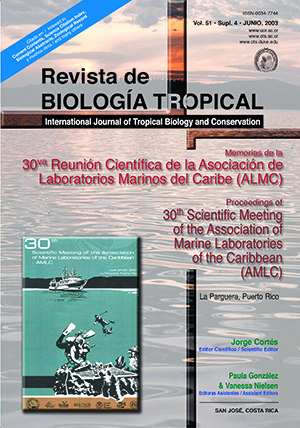Abstract
Perna genus was introduced to Venezuela, but nowadays, Perna perna and Perna viridis coexist and are commercially exploited from their natural beds. The aim of this work was to determine the effect of salinity on the physiological conditions of these species by studying RNA/DNA and Protein/DNA ratios. The organisms were collected from natural beds at La Esmeralda, Sucre State, Venezuela, and acclimatized for 15 days under laboratory conditions at 25ºC, 36‰ salinity, pH between 7 and 8 and more than 90% of oxygen saturation. Later, they were divided in two groups: for one group, the salinity concentration was increased (36 to 45‰), and for the other, the salinity was decreased (36 to 15‰). The rate of change was 1‰ every day. Ten organisms per group of both species were taken at each of 15, 20, 25, 30, 36, 40 y 45‰ salinity concentrations. Protein (colorimetric method) and nucleic acids (RNA and DNA by fluorometric method) concentrations were measured in the digestive gland, gills and adductor muscle tissues. Results indicate that P. perna can physiologically compensate the increase in salinity, but not when the salinity decreased, when proteins are the most needed macromolecules. The Protein/DNA index is directly related to salinity changes in both cases. P. viridis shows physiological compensation to salinity increases and decreases. The RNA/DNA index value in both cases supports this. Digestive gland and muscle tissues are the regulating tissues in both species. These results show that P. viridis has a higher degree of adaptability to salinity changes and, therefore, a greater potential for aquaculture than P. perna.References
Bradford, M.M. 1976. A rapid and sensitive method for the quantification of protein utilizing principles of protein dye binding. Anal. Biochem. 72: 248-254.
Bracho, M.A., M.I. Segnini de Bravo, I. Viñoles & K.S. Chung. 2000. Efecto de la alimentación sobre la condición fisiológica del mejillón Perna viridis (Bivalvia: Mytilidae), según el cociente ARN/ADN. In: Cortés J. & A.C. Fonseca (eds.). Proceedings of the 29th Meeting of the Association of Marine Laboratories of the Caribbean (AMLC). Rev. Biol. Trop. 48 (Supl. 1): 171-182.
Gómez, J.A. 1991. Inducción de la reproducción y cambios en la composición química de Pecten ziczac acondicionadas durante los períodos de reproducción activa y reposo sexual de las poblaciones naturales. Tesis de Maestría. Universidad de Oriente, Cumaná, Venezuela. 65 p.
Hicks, D.W., D.L. Hawkins & R.F. McMahon. 2000. Salinity tolerance of brown mussel Perna perna (L.) from the Gulf of Mexico: An extension of life table analysis to estimate median survival time in the presence of regressor variables. J. Shellfish Res. 19: 203-212.
Jordán, N. 1990. Relación de la temperatura, clorofila a y ácidos grasos fitoplantónicos con la actividad gonadal anual de Pecten ziczac (L. 1758). Sustratos metabólicos para la reproducción. Tesis de Maestría. Universidad de Oriente, Cumaná, Venezuela. 75 p.
Karsten, U. & A. Wollemberger. 1972. Determination of DNA and RNA in homogenized cells and tissues by surface fluorometry. Anal. Biochem. 46: 135-148.
Karsten, U. & A. Wollemberger. 1977. Improvements in the ethidium bromide method for a direct fluorometric estimation of DNA in cell tissue homogenates. Anal. Biochem. 77: 464-470.
Nusetti, O.A. & D. Morales. 1988. Crecimiento de algunos tejidos del mejillón Perna perna (L. 1758): Composición de ADN, relaciones ARN/ADN, y reservas energéticas. Acta Cient. Venezuela 39: 289-293.
Rylander, J., J. Pérez, & J.A. Gómez, 1996. Status of green mussel Perna viridis (Linnaeus, 1758) (Mollusca: Mytilidae) in north-eastern Venezuela. Caribb. Mar. Stud. 5: 86-87.
Segnini de Bravo, M.I., Chung, K.S. & J.E. Pérez. 1998. Salinity and temperature tolerance of green mussel Perna viridis (Bivalvia: Mytilidae). Rev. Biol. Trop. 46 (Supl. 5): 121-125. Soot-Ryen. 1955. A report on the family Mytilidae (Pelecypoda). Hancoock Pacific Expedition. 20: 1-175.
Tejera, E., I. Oñate, M. Núñez & C. Lodeiros. 2000. Crecimiento inicial del mejillón marrón (Perna perna) y verde (Perna viridis) bajo condiciones de cultivo suspendido en el Golfo de Cariaco, Venezuela. Bol. Centro Inv. Biol. 34: 143-158.
Vélez, A.R. 1971. Fluctuación mensual del índice de engorde del mejillón Perna perna natural y cultivado. Bol. Inst. Oceanog. UDO, Venezuela. 10: 3-8.
Viñoles, I.V., M.I. Segnini de Bravo, M.A. Bracho & K.S. Chung. 2000. Efecto de la temperatura de aclimatación sobre el crecimiento instantáneo de Perna viridis (Bivalvia: Mytilidae) según el cociente ARN /ADN. In: Cortés J. & A.C. Fonseca (eds.). Proceedings of the 29th Meeting of the Association of Marine Laboratories of the Caribbean (AMLC). Rev. Biol. Trop. 48 (Supl. 1): 159-170.
##plugins.facebook.comentarios##

This work is licensed under a Creative Commons Attribution 4.0 International License.
Copyright (c) 2003 Revista de Biología Tropical


